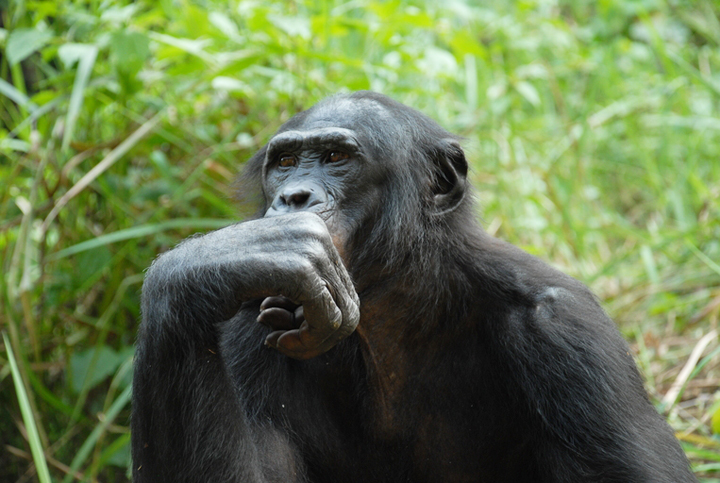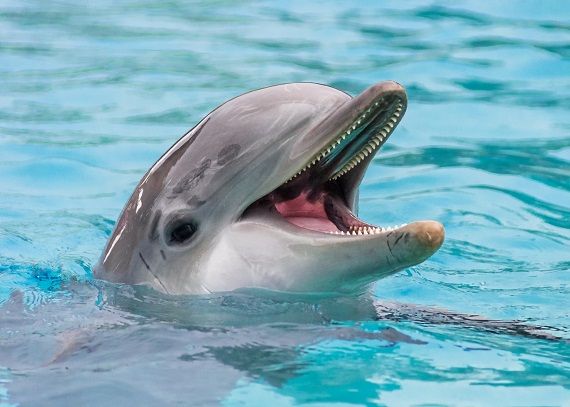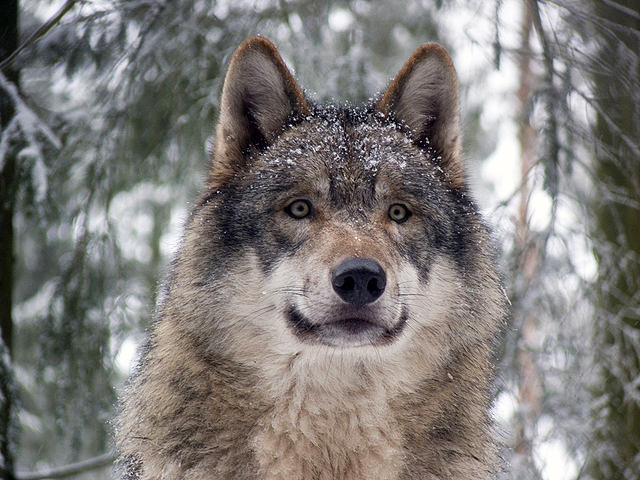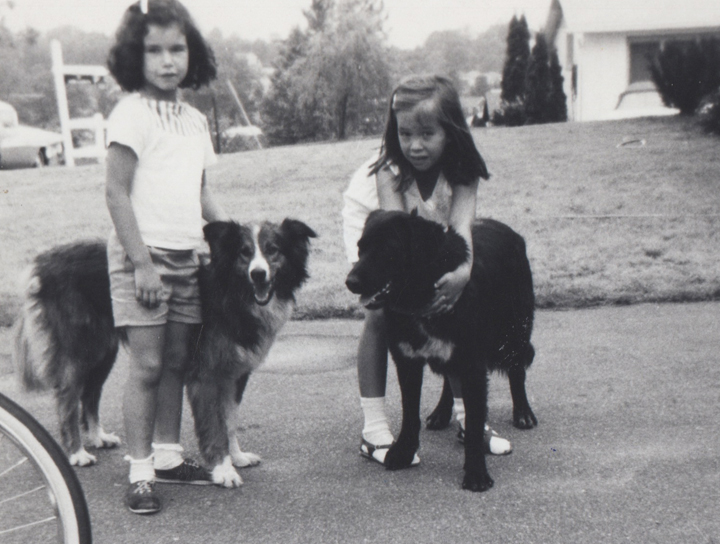Animals Do Have Emotions, But What Should We Call Them?
We share a lot with other animals—emotionally, cognitively, and neuro-chemically—but many humans still use outdated linguistic distinctions that put animals in their (allegedly inferior) place.
By Vicki Croke

Bonobos, among the closest primates to humans, will share food with strangers. Researchers believe this behavior helps us understand the beginnings of human altruism. Pierre Fidenci via Wikimedia Commons.
Humans speak. Animals vocalize.
We love. They bond.
We form friendships, they maintain social bonds.
We feel jealous. They resource guard.
We have sex, they copulate.
Notice a pattern?
We humans seem determined to separate ourselves from the rest of the animal kingdom, even if we have to cheat. And sometimes it does sound like cheating. Because while scientists continue piling up the evidence, documenting how much we share with other animals—emotionally, cognitively, and neuro-chemically—many humans still use outdated linguistic distinctions that put animals in their (allegedly inferior) place.
Robin Young and Vicki have a lively discussion on Here & Now about animal emotions and the words we use in describing them:
Just last month, for instance, a new study, published in PLOS ONE, indicated that dogs experience jealousy. That’s a complex emotion—combining other emotions such as anger and resentment—and it has always been considered uniquely human.
But that’s only one of the latest examples of science finding “human” traits in the animal world. Ever since Jane Goodall, in 1960, saw chimps stripping leaves from twigs so they could fish for termites—thus trashing humans’ exclusive claim to be “the tool user”—our species has found its specialness under siege. By now, many of the traits we used to think were ours alone have proven to be no more exclusive than membership in the cellphone butt-dialer’s club.
To recap just a few: Rats display regret. Elephants appear to mourn their dead. Dogs are terrific at reading human emotion, even doing something we do: scanning the right side of human faces (which some researchers say is the more expressive side). The kind of consciousness that is required to recognize oneself in a mirror? Along with humans, some apes, elephants, killer whales, dolphins, and magpies have passed the mirror recognition test.
Cooperation, compassion, play, altruism, a sense of fairness? They all show up among the animals, along with some of the bad stuff: Chimps can deliberately deceive one another and people.
And it goes deeper. Not only can we find human-like behavior and thought in some animals; thanks to technology including MRI, we can also see when brain areas that are activated in animals, and the chemicals that percolate, mirror our own brain functions. For example, spindle cells, which appear to be important in processing emotion, were once thought to be particular to us and to great apes; now we know they’re also abundant in the brains of whales.
One study from Hungary found that listening to the sound of crying or laughter causes the same reaction in dog brains as it does in humans ones for instance.
Bottlenose dolphins have passed the mirror recognition test. Photo: lolilujah via Flickr Creative Commons.

So, if animals are proving to be so like us, why do we resist describing their experiences with the same terms we apply to ourselves? Are we afraid of being accused of being unscientific? If so, we’ve got it backward. “It’s bad science to rob animals of their cognitive, emotional, and moral capacities,” says Marc Bekoff, an evolutionary biologist and authority on animal behavior and emotion. In his book “The Emotional Lives of Animals,” he writes that
“It’s bad biology to argue against the existence of animal emotions. Scientific research in evolutionary biology, cognitive ethology, and social neuroscience supports the view that numerous and diverse animals have rich and deep emotional lives.”
So maybe it’s anthropomorphism—the projection of human characteristics onto nonhuman animals—that we’re afraid of. Again, we’d be off.
Modern thinkers like author Laurel Braitman say that the right kind of anthropomorphism is, if anything, scientifically sound. In her book “Animal Madness: How Anxious Dogs, Compulsive Parrots, Gorillas on Drugs, and Elephants in Recovery Show Us the Wildness of Our Own Minds,” she says that we can choose “to anthropomorphize well and by doing so, make more accurate interpretations of other animals’ behavior and emotional lives. Instead of human projection, anthropomorphism may instead be a recognition of bits and pieces of our human selves in other animals and vice versa.”
She’s in good company. Bekoff points out that emotion is important to all social creatures—helping us to bond, to navigate relationships, and to protect ourselves. As Elizabeth Marshall Thomas, the famed author and anthropologist, puts it,
“consciousness is something we acquired through our long mammalian past. Thoughts and emotions have evolutionary value.”
Best-selling nature writer Sy Montgomery agrees. “We talk about being anthropomorphic, about attributing human traits to animals,” she says by phone from her home in New Hampshire. “Who says those traits are human? Who said we came up with them? Evolution says we did not come up with them. Evolution says we inherited them.”
Ethologist Marc Bekoff asks why we resist saying that animals like wolves form friendships with one another. Gunnar Ries Amphibol via Wikimedia Commons.

If it sounds like cursive writing and car repair are going to be the only unique accomplishments our species can still claim, don’t worry. We don’t have to exaggerate the differences to tell the difference between ourselves and dogs or dodos. Yet many people persist in denying abilities and emotions to animals, along with the “human” words for those traits.
Some words are particularly contentious when applied to animals. In 1993, Liz Thomas, described the relationship between two huskies as a marriage in her blockbuster book “The Hidden Life of Dogs.” That really made some people angry, and yet, albatross couples may stay true to one another for 55 years, while Britney Spears was once married for only 55 hours. In fact, the average length of a marriage before it ends in divorce here in the US is 8 years, according to The Economist.
Today, Bekoff points out, some people hate to admit that animals maintain friendships with each other. The prejudice is so widespread that “friend” seems like a dirty word when applied to animals. In fact, Bekoff calls it the other “F-word.” He thinks it’s ridiculous.
“What else would you call a relationship between, say, two dogs or two wolves or certain wild coyotes where they hang out, they travel together, they do all things together—I’m not necessarily talking about mates—and then one dies or disappears and the other grieves or seeks them out? You know? Long-term social bond? Reciprocal interaction? Blah blah blah. What else would you call it but a friend?”
I know exactly what Bekoff is talking about. Growing up in suburban Boston, my sister and I used to play with the Morris kids down the street, and our dog Penny played with the Morris’s dog Cleo. Long after we humans stopped hanging out together, our dogs continued to meet.
Left: Vicki and Penny hanging out with neighborhood friends. Penny’s friendships with other dogs were deep and long lasting.

Cleo would show up on our doorstep (this was before strict leash laws) and her rudder-like tail would bang against the storm door, announcing her presence. We’d hear her “knock” and let Penny out. One of the most heartbreaking moments in our lives came when, a few days after our beloved Penny died at the age of 15, we heard Cleo at the door. That day, instead of letting Penny out, we invited Cleo in. And we all cried.
We as a species can continue to argue over things like whether or not animals can befriend each other, feel jealousy, be altruistic, mourn, feel joy, understand fairness. I know which side of the argument I’m on. I learned the answer from Penny and Cleo.

9 Responses to “Animals Do Have Emotions, But What Should We Call Them?”
Not only must we decry racism, we should treat specisism the same way. Thank you for this article.
“If it sounds like cursive writing and car repair are going to be the only unique accomplishments our species can still claim, don’t worry.”
Thanks, Vicki, for the great article!
Anyone who has ever had a pet knows that animals have very unique and distinct personalities – they are not automatons or robots, but truly unique and individual little creatures. It has always struck me that this says something quite profound about how fundamental our own personalities are, and that our personalities are not as heavily dependent upon our intelligence as we might think.
It seems to me that part and parcel of having a distinct personality is having distinct likes and dislikes that affect one’s reactions to the world. As such, if animals have personalities, they must have things they like more than other things – which presumably can include other animals, people, locations and etc.
Obviously this is all speculation, but to me the meager evidence points strongly to animals having personalities and favorites – both other creatures and behavioral tendencies. What a wonderful world that should have such creatures in it.
The sad day came when we finally had to let our beloved Lab, Phoebe, go after 18 months of treatment for lymphoma. She’d been a Mother’s Day gift, and she was my dog, seldom found more than a couple of feet from me. We had another Lab, because we believe that dogs deserve partners. When we finally had the vet come and ease Phoebe’s passing, my husband and I grieved, but our other Lab, Chloe, simply couldn’t stop looking for Phoebe, crying and moaning for days on end. We’d lost our home in a fire and were living in an apartment, so we weren’t in a hurry to get another dog we’d have to walk several times a day; however, it became clear that Chloe needed a pet of her own. We registered with a Lab rescue center, and within a couple of days, we were a pack of four once again. Anyone who has lived in close proximity with dogs knows that they have emotions; watching a dog grieve for her beloved friend was as heartbreaking as watching any human do the same.
Kate, we are with you! What a moving story of the love and friendship between Phoebe and Chloe. This goes to the very heart of the discussion.
Thank you for sharing.
Vicki
This is such a beautiful story, thank you for sharing. So glad you decided to get another friend for your baby, AND that you chose a lab rescue…..
It is refreshing to hear anybody admit that animals have the same emotions as humans. After all the centuries of humans teaching that “animals” are our inferiors and for our use, to work for us and for us to eat. It is as bad as slavery, treating them as subordinates. Anybody who opens his eyes could see that they are the same in their feelings and relationships. It is so sad because so few of us, even now, realize the truth.
Have you ever heard a dog howl when his master has died?I know thAt sound and that was how I knew my landlord bad died his dog stood outside and howled one time but I weep remembering that sound
It takes three clear steps to fully experience higher emotion: 1. the trigger, what causes it. 2. the expression, the response. and 3. the analysis, or how it made you feel and what do to next. Animals perform the first two. Humans perform all three. If it weren’t for that third step, everything would simply be written off as instinct. If animals could perform all three, the dictum of animal behaviour would have to be rewritten entirely, and not filtered through the feel-good talk of Peter Singer, Marc Bekoff and the like. So far, even after many centuries of observation, this has yet to happen. Animals will continue to act without regard to anything more than the here-and-now, doing the same action over and over as nature dictates, that is, until a -human- intervenes, then all of a sudden you can observe an animal acting in such a way that allows humans to assume—through their reference of *human* emotions and reactions—-what an animal is thinking, doing, or whatever….and to any scientist NOT involved with animals, would EASILY see that as 100% anecdotal assumption.
That is one of the many main things different between man and animal. Claiming the emotional projection humans do to their pets is a way for man to understand his animal nature is zoomorphic and borderline misanthropic. With things like orality, literacy, metacognition, the faculties to appreciate art and contain disease in play (all which involve higher faculties), I simply can’t take any deep-ecological or animal rights argument seriously, especially anything coming out of CU Boulder.
And I don’t think using dogs for any example of animal intelligence is fair….humans had a direct hand in shaping them into the myriad breeds they are now and can breed all sorts of stuff in and out of them at will. Dogs are pretty much furry, programmable extensions of humans and nothing more, not the wolves they once were millennia ago. They serve no other natural purpose. Even “feral” dogs are attracted by human environments.
Comments are closed.